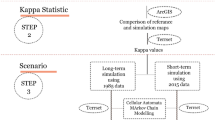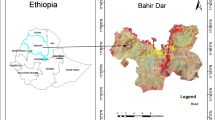Abstract
This chapter presents a logistic based cellular automata model to simulate the continuous process of urban growth in space and over time. The model is constructed based on an understanding from empirical studies that urban growth is a continuous spatial diffusion process which can be described through the logistic function. It extends from previous research on cellular automata and logistic regression modelling by introducing continuous data to represent the progressive transition of land from rural to urban use. Specifically, the model contributes to urban cellular automata modelling by (1) applying continuous data ranging from 0 to 1 inclusive to represent the none-discrete state of cells from non-urban to urban, with 0 and 1 representing non-urban and urban state respectively, and all other values between 0 and 1 (exclusive) representing a stage where the land use is transiting from non-urban to urban state; (2) extending the typical categorical data based logistic regression model to using continuous data to generate a probability surface which is used in a logistic growth function to simulate the continuous process of urban growth. The proposed model was applied to a fast growing region in Queensland’s Gold Coast City, Australia.
Access this chapter
Tax calculation will be finalised at checkout
Purchases are for personal use only
Similar content being viewed by others
References
Almeida, C. M., Gleriani, J. M., Castejon, E. F., & Soares-Filho, B. S. (2008). Using neural networks and cellular automata for modelling intra-urban land-use dynamics. International Journal of Geographical Information Science, 22, 943–963.
Australian Bureau of Statistics. (2005). Information paper: Draft mesh blocks, Australia, 2005 ABS Cat. No. 1209.0.55.001.
Australian Bureau of Statistics. (2006). CDATA Online. Canberra: Australian Bureau of Statistics. http://www.abs.gov.au/CDATAOnline. Accessed 01 Aug 2011.
Australian Bureau of Statistics. (2011). Regional Population Growth, Australia, 2009–10 ABS Cat. No. 3218.0.
Bryant, C. R., Russwurm, L. H., & McLellan, A. G. (1982). The city’s countryside: Land and its management in the rural-urban fringe. New York: Longman.
Cheng, J., & Masser, I. (2004). Understanding spatial and temporal processes of urban growth: Cellular automata modelling. Environment and Planning B: Planning and Design, 31, 167–194.
Clarke, K. C., & Gaydos, L. J. (1998). Loose-coupling a cellular automaton model and GIS: Long-term urban growth prediction for San Francisco and Washington/Baltimore. International Journal of Geographical Information Science, 12, 699–714.
Clarke, K. C., Hoppen, S., & Gaydos, L. J. (1997). A self-modifying cellular automaton model of historical urbanization in the San Franciso Bay area. Environment and Planning B: Planning and Design, 24, 247–261.
Dendoncker, N., Rounsevell, M., & Bogaert, P. (2007). Spatial analysis and modelling of land use distributions in Belgium. Computers, Environment and Urban Systems, 31, 188–205.
Department of Infrastructure and Planning. (2009). South East Queensland Regional Plan 2009–2031. Brisbane: Queensland Government. http://www.dlgp.qld.gov.au/regional-planning/south-east-queensland-regional-plan-2009-2031.html. Accessed 30 Aug 2011.
Dragićević, S. (2004). Coupling fuzzy sets theory and GIS-based cellular automata for land-use change modelling. In Fuzzy Information, IEEE Annual Meeting of the Processing NAFIPS’04, Banff, pp. 203–207.
Fang, S., Gertner, G. Z., Sun, Z., & Anderson, A. A. (2005). The impact of interactions in spatial simulation of the dynamics of urban sprawl. Landscape and Urban Planning, 73, 294–306.
Feng, Y. J., Liu, Y., Tong, X. H., Liu, M. L., & Deng, S. (2011). Modeling dynamic urban growth using cellular automata and particle swarm optimization rules. Landscape and Urban Planning, 102, 188–196.
Gobim, A., Campling, P., & Feyen, J. (2002). Logistic modeling to derive agricultural land determinants: A case study from southeastern Nigeria. Agriculture, Ecosystem and Environment, 89, 213–228.
Grimm, V., & Railsback, S. F. (2005). Individual-based modeling and ecology. Princeton: Princeton University Press.
Grimm, V., & Railsback, S. F. (2012). Designing, formulating and communicating agent-based models. In A. J. Heppenstall, A. T. Crooks, L. M. See, & M. Batty (Eds.), Agent-based models of geographical systems (pp. 361–377). Dordrecht: Springer.
Grimm, V., Berger, U., Bastiansen, F., Eliassen, S., Ginot, V., Giske, J., Goss-Custard, J., Grand, T., Heinz, S., Huse, G., Huth, A., Jepsen, J. U., Jørgensen, C., Mooij, W. M., Müller, B., Pe’er, G., Piou, C., Railsback, S. F., Robbins, A. M., Robbins, M. M., Rossmanith, E., Rüger, N., Strand, E., Souissi, S., Stillman, R. A., Vabø, R., Visser, U., & DeAngelis, D. L. (2006). A standard protocol for describing individual-based and agent-based models. Ecological Modelling, 198, 115–126.
Grimm, V., Berger, U., DeAngelis, D. L., Polhill, J. G., Giske, J., & Railsback, S. F. (2010). The ODD protocol: A review and first update. Ecological Modelling, 221(23), 2760–2768. doi:10.1016/j.ecolmodel.2010.08.019.
Herbert, D. T., & Thomas, C. J. (1997). Cities in space: City as place (3rd ed.). London: David Fulton.
Iltanen, S. (2012). Cellular automata in urban spatial modelling. In A. J. Heppenstall, A. T. Crooks, L. M. See, & M. Batty (Eds.), Agent-based models of geographical systems (pp. 69–84). Dordrecht: Springer.
Jakobson, L., & Prakash, V. (1971). Urbanization and national development. Beverley Hills: Sage.
John, F. B., Peter, W. N., Peter, H., & Peter, N. (1985). The future of urban form: The impact of new technology. London: Croom Helm.
Li, H., & Wu, J. (2004). Use and misuse of landscape indices. Landscape Ecology, 19, 389–399.
Li, X., & Yeh, A. G. O. (2000). Modelling sustainable urban development by the integration of constrained cellular automata and GIS. International Journal of Geographical Information Science, 14, 131–152.
Li, X., & Yeh, A. G. O. (2002a). Urban simulation using principal components analysis and cellular automata for land-use planning. Photogrammetric Engineering and Remote Sensing, 68(4), 341–351.
Li, X., & Yeh, A. G. O. (2002b). Neural-network-based cellular automata for simulating multiple land use changes using GIS. International Journal of Geographical Information Science, 16(4), 323–343.
Linge, G. J. R. (1965). The delimitation of urban boundaries for statistical purposes with special reference to Australia. Canberra: Australia National University.
Liu, Y. (2008). Modelling urban development with geographical information systems and cellular automata. New York: CRC Press.
Liu, Y., & Phinn, S. R. (2003). Modelling urban development with cellular automata incorporating fuzzy-set approaches. Computers, Environment and Urban Systems, 27, 637–658.
Liu, X., Li, X., Shi, X., Wu, S., & Liu, T. (2008a). Simulating complex urban development using kernel based non-linear cellular automata. Ecological Modelling, 211(1–2), 169–181.
Liu, X., Li, X., Liu, L., He, J., & Ai, B. (2008b). A bottom-up approach to discover transition rules of cellular automata using ant intelligence. International Journal of Geographical Information Science, 22(11), 1247–1269.
Mandelas, E. A., Hatzichristos, T., & Prastacos, P. (2007). A fuzzy cellular automata based shell for modeling urban growth – a pilot application in Mesogia area. In 10th AGILE International Conference on Geographic Information Science 2007, Denmark.
McGarigal, K., Cushman, S. A., Neel, M. C., & Ene, E. (2002). FRAGSTATS: Spatial pattern analysis program for categorical maps. Computer software program produced by the authors at the University of Massachusetts, Amherst. http://www.umass.edu/landeco/research/fragstats/fragstats.html. Accessed 03 May 2011.
Office of Economic and Statistical Research. (2010). Population and housing profile – Gold Coast City council. Brisbane: Queensland Government. http://www.oesr.qld.gov.au/products/profiles/pop-housing-profiles-lga/pop-housing-profile-gold-coast.pdf. Accessed 30 Aug 2011.
Openshaw, S. (1984). The modifiable areal unit problem. In Concepts and techniques in modern geography 38. Norwich: Geo Books.
Potter, R., Binns, T., Elliott, J. A., & Smith, D. (2003). Geographies of development (2nd ed.). London: Longman.
Power, C., Simms, A., & White, R. (2001). Hierarchical fuzzy pattern matching for the regional comparison of land use maps. International Journal of Geographical Information Science , 15(1), 77–100.
Pryor, R. J. (1968). Defining the rural-urban fringe. Social Forces, 202–215.
Sherrod, P. H. (2010). DTREG: Predictive modeling software. http://www.dtreg.com/DTREG.pdf. Accessed 01 May 2011.
Sui, D. Z., & Zeng, H. (2001). Modeling the dynamics of landscape structure in Asia’s emerging desakota regions: A case study in Shenzhen. Landscape and Urban Planning, 53, 37–52.
Verburg, P. H., Soepboer, W., Veldkamp, A., Limpiada, R., Espaldon, V., & Mastura, S. (2002). Modeling the spatial dynamics of regional land use: The CLUE-S model. Environmental Management, 30(3), 391–405.
Ward, D. P., Murray, A. T., & Phinn, S. R. (2000). Monitoring growth in rapidly urbanizing areas using remotely sensed data. The Professional Geographer, 52, 371–386.
Ward, D. P., Murray, A. T., & Phinn, S. R. (2003). Integrating spatial optimization and cellular automata for evaluating urban change. The Annuals of Regional Science, 37, 131–148.
White, R. W., & Engelen, G. (1993). Cellular automata and fractal urban form: A cellular modelling approach to the evolution of urban land use patterns. Environment and Planning A, 25, 1175–1193.
Wu, F. (1996). A linguistic cellular automata simulation approach for sustainable land development in a fast growing region. Computers, Environment, and Urban Systems, 20, 367–387.
Wu, F. (1998a). An experiment on the generic polycentricity of urban growth in a cellular automatic city. Environment and Planning B: Planning and Design, 25, 731–752.
Wu, F. (1998b). Simulating urban encroachment on rural land with fuzzy-logic-controlled cellular automata in a geographical information system. Journal of Environmental Management, 53(16), 293–308.
Wu, F. (1998c). SimLand: A prototype to simulate land conversion through the integrated GIS and CA with AHP-derived transition rules. International Journal of Geographical Information Science, 12, 63–82.
Wu, F. (2002). Calibration of stochastic cellular automata: The application to rural-urban land conversions. International Journal of Geographical Information Science, 16(8), 795–818.
Wu, F., & Webster, C. J. (1998). Simulation of land development through the integration of cellular automata and multicriteria evaluation. Environment and Planning B: Planning and Design, 25, 103–126.
Wu, F., & Yeh, A. G. O. (1997). Changing spatial distribution and determinants of land development in Chinese cities in the transition from a centrally planned economy to a socialist market economy: A case study of Guangzhou. Urban Studies, 34, 1851–1879.
Yang, Q., Li, X., & Shi, X. (2008). Cellular automata for simulating land use changes based on support vector machines. Computers and Geosciences, 34(6), 592–602.
Zhu, Z., Liu, L., Chen, Z., Zhang, J., & Verburg, P. H. (2009). Land-use change simulation and assessment of driving factors in the loess hilly region – a case study as Pengyang County. Environmental Monitoring and Assessment, 164(1–4), 133–142.
Author information
Authors and Affiliations
Corresponding author
Editor information
Editors and Affiliations
Rights and permissions
Copyright information
© 2012 Springer Science+Business Media B.V.
About this chapter
Cite this chapter
Liu, Y., Feng, Y. (2012). A Logistic Based Cellular Automata Model for Continuous Urban Growth Simulation: A Case Study of the Gold Coast City, Australia. In: Heppenstall, A., Crooks, A., See, L., Batty, M. (eds) Agent-Based Models of Geographical Systems. Springer, Dordrecht. https://doi.org/10.1007/978-90-481-8927-4_32
Download citation
DOI: https://doi.org/10.1007/978-90-481-8927-4_32
Published:
Publisher Name: Springer, Dordrecht
Print ISBN: 978-90-481-8926-7
Online ISBN: 978-90-481-8927-4
eBook Packages: Humanities, Social Sciences and LawSocial Sciences (R0)




